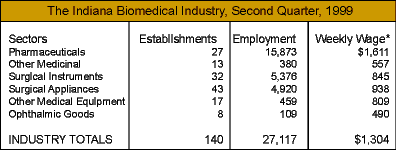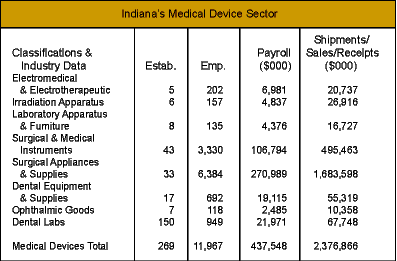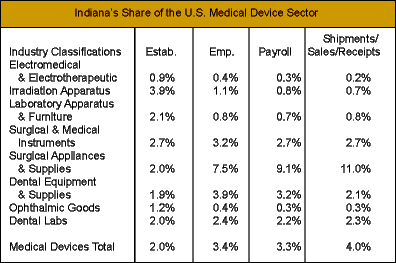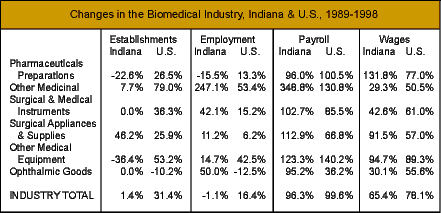Indiana's Biomedical Industry Today (Part II)
Ted Jockel and Leslie Richardson
Indiana Department of Commerce
In the second quarter of 1999, Indiana had 140 establishments that were primary producers of medical- and biotech-related products, with a combined employment of 27,117 workers. Employment in this industry accounts for less than 4% of Indiana's manufacturing workforce. Industry payrolls, however, amount to nearly 7% of total Indiana manufacturing payroll, with average weekly wages of $1,304. These wages exceed the state average for all private employment by 135% and the state average for manufacturing by 68%.
The Medical Device Sector in Detail
The 1997 U.S. Economic Census permits a detailed look at the medical device sector of the medical and biotech industry. Unfortunately, data on the pharmaceutical sector is not available at this time due to confidentiality restrictions. The medical device sector is broken down under the new NAICS coding system into eight product-related categories.
NAICS
The North American Industry Classification System (NAICS) is replacing the U.S. Standard Industrial Classification (SIC) system. NAICS was developed jointly by the U.S., Canada, and Mexico to provide new comparability in statistics about business activity across North America. NAICS reflects the enormous changes in technology and in the growth and diversification of services that have marked recent decades.


Source: Indiana Dept. of Workforce Development, Covered Employment and Wages;
data collected and sorted by SIC Codes.
* Wages reflect second quarter
only. Annual wages may actually be higher as they will include wages for all
quarters. First- and fourth-quarter wages often include one-time annual bonuses.
At first glance, the medical device sector may look weak in the high-skill, high-wage areas, but a closer look at the data suggests that medical devices is anything but a low-tech or low-wage sector. Surgical and medical instruments and surgical appliances and supplies dominate the sector. While instruments manufacturing is generally high-tech, the appliances and supplies sub-sector is often (but mistakenly) considered a low-technology, low-skill area in Indiana. In employment, the appliances and supplies sub-sector ranks fourth in the United States and in shipments/sales/receipts second nationally. Indiana also ranks second in average pay ($42,448) and is among the leading states in productivity in this sub-sector.

The data indicate, therefore, that rather than being low-tech, surgical appliances and supplies are high-value products produced by a highly skilled workforce. The electromedical sub-sector is another high-skill, high-wage element of medical devices. Unfortunately, the number of workers employed by the electromedical devices manufacturers is difficult to isolate. Most manufacturers of electromedical devices are primarily electronics manufacturers and classified as such. Given Indiana's large electrical and electronics industry, there is a considerable amount of hidden electromedical-related employment (see tables below).


Indiana's combined medical device sector, led by surgical appliances and supplies, is a major player in the national scene. Indiana surgical appliances and supplies ranks 15th in the total number of establishments nationally but ranks 11th in employment. In annual average wages, Indiana ranks ninth at $36,563, which is just under the national wage of $36,839. Most importantly, Indiana ranks seventh in total shipments/sales/receipts.
Trends in the Industry
Overall, employment in Indiana's medical and biotech industry has declined by 1.1% between 1989 and 1998. However, in the two largest medical device sectors, employment has increased at twice the rate of the nation. Growth in these sectors began to slow in 1998 and into 1999 in Indiana. U.S. employment figures do not clearly indicate if this is a local or national trend. Employment in the pharmaceutical sector in Indiana has declined while U.S. employment has risen; this trend should reverse as Eli Lilly and Company begins its major expansion over the next decade. The aging of the U.S. population is a factor that leads most industry analysts to anticipate continuing growth in each sector of this industry (see figure 1).

Indiana's Biomedical Future
Indiana, with its existing manufacturing base, research and educational facilities, and current public policy emphasis on high-technology business, is in a position to see further growth in the medical and biotech industry. In addition to the well-broadcast expansion of Eli Lilly and other similar companies, efforts are underway to stimulate new ventures and entrepreneurism in this industry. These efforts include the 21st Century Research and Technology Fund established by the State of Indiana to leverage federal research dollars, support technology transfer and stimulate new private-sector research. The state legislature has appropriated $50 million to the Fund for the 1999-2001 biennium. The state's two major research universities, Indiana University and Purdue University, also attract approximately $350 million in federal research grants each year. Of that amount, $200 million goes to research related to the biomedical and medical industry. Industry leaders including Clarian Health, Eli Lilly, Roche Diagnostics and Dow AgroSciences joined with the state's research universities and the City of Indianapolis to form the MedAmerica Research Corridor. The purpose of this statewide collaboration is to attract and nurture new biomedical companies interested in locating in central Indiana.
Nevertheless, risks to the industry's future growth also exist in Indiana. Because this is a targeted industry, heavy competition between states for new operations and expansions will be intense. At the same time, rising medical costs may place pressure on producers to reduce costs through employment cutbacks or relocations outside the U.S., where labor is less expensive. Even positive situations might cause short-term difficulties as companies compete for labor in a tight market.
